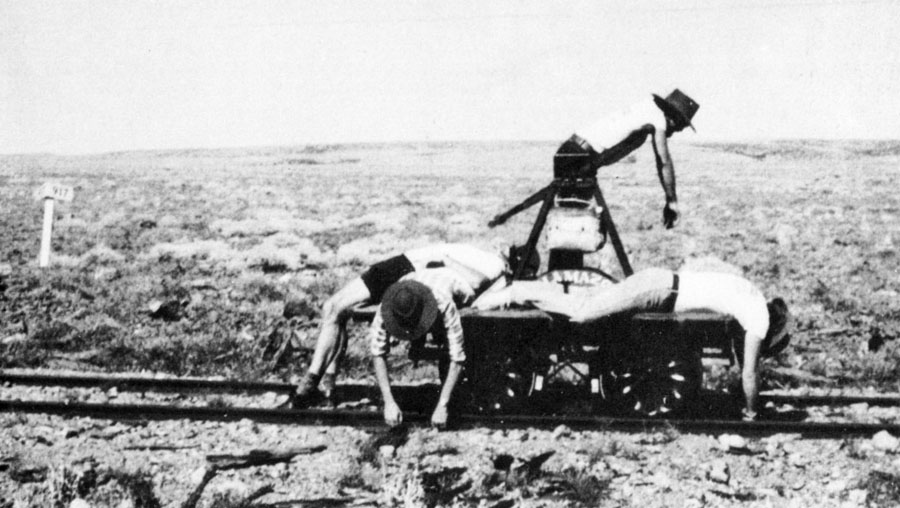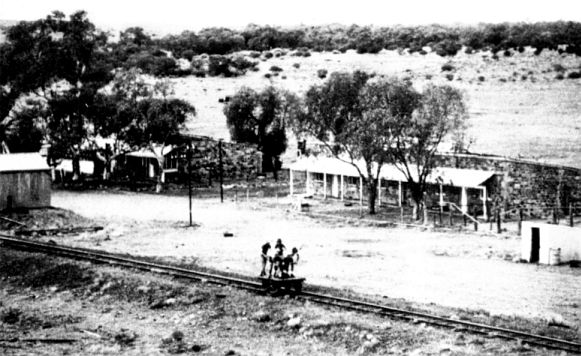This article by Jeremy Browne was originally published in the Spring 1981 edition of the Pichi Richi Patter.

At 12.30 p.m. Central Standard Time on Tuesday 7 October 1980 a 'Kalamazoo’ 1 railway section car arrived at Alice Springs, proving conclusively that the early railway employees in the area may have migrated from the south in a like manner.
Dawn, Day Two. Wednesday 1 October. The day dawned gently. Pichi Richi stalwarts Peter 'Cigarette' Letheby and Max 'Wangianna' Munchenberg were busy photographing the dawn while the remainder of the party stirred from the previous night's hungover sleep; some in the small fettlers' rooms festooned with nude pin-ups, others from camp stretchers outside the ATCO huts which made up the camp at Curdimurka, 101 km by rail from Marree.

'I must be crazy', muttered Royce 'Motor Mouth' Jowett from the Bellarine Peninsula Railway in Victoria and guilty of mooting the original crazy idea. Royce was temporarily immobilised as one of the many camp dogs had stolen his shoes, another handing out the same rough justice to team leader Jerry 'Pump Harder' Browne.
Behind our party lay the rotting track from Marree. Callana – Wangianna – Wangianna Bank – WANGIANNA BANK!!! Here the vocal Marree locals had predicted the attempt would founder, and it nearly did. Alberrie Creek – Boopeechie – Lake Eyre. Head wind all the way and a good 40°C by lunchtime. Not enough pre-event training, too much playing up on the train from Port Augusta and too many eggs for breakfast had all contributed to a weary first day, the 101 km being covered at an average of a bare 12.8 km/hour. A superb five course meal by Graham 'Le Chef' Bowes including vintage claret had eased the pain somewhat but with a frighteningly long way to go the team was far from confident that first night.
Just why were these pioneers camped at Curdimurka? Had desert madness taken its deadly grip?
Our story begins in 1977 when Jerry Browne began making noises about running the last Ghan as a steam hauled special. Fortunes swayed to and fro and at one stage in 1979, the trip was beginning to look a distinct possibility, however logistic problems, an earlier than planned completion date and the visit of H.R.H. Princess Alexandra and Mr. Princess Alexandra combined to make ANR decide the trip was just too much to handle, in many ways much to the organiser's relief.
One of the locos considered was Bellarine's T class and it was during discussions with Royce Jowett that the very vague idea of the Kalamazoo trip was born. Despite the sheer idiocy of the idea, it grew and grew until, in early 1980 it was back to ANR to seek permission for a different trip! With the Chairman's 'approval in principle' it was a question of organising the detail. ANR Promotions Manager Neil Travers came to the rescue, and with the guiding hand of Chief Civil Engineer Des Smith, arrangements were made for the party to travel as a track inspection gang in the company of a Road Master carrying out a regular track inspection.
The publicity would provide a good build-up to the first train on the new line which would justify ANR's involvement.
A budget of $5000 was produced and sponsors approached, the S.A. Brewing Company assuming the role of major sponsor with B.H.P. 'The Big Australian', Yakka Clothing and the Northern Territory Tourist Board as the other main sponsors. The trip coincided with the release of the 'Ghan can' from the Southwark Brewery and, in fact, the first 40 dozen off the production line went on the trolley, being eagerly clutched as souvenirs all along the line.
Dispute arose during the trip as to whether the cans constituted legal 'fuel', but when one considers 42 degrees celsius heat, desert delirium and strenuous exertion, it could hardly be considered as anything else! The final consumption figure of 10 miles per gallon would seem to confirm this.
Meanwhile, the Victorian contingent, all from the Bellarine Peninsula Railway, had arranged to borrow a Kalamazoo from the Tasmanian Museum of Transport in Hobart where it was on loan from its owner, David Beck. It was shipped to Queenscliff and in July the S.A. party went over for a test run. Alas, years out in the open had taken their toll and there was a ton of work to be done if there was to be any chance of making our target. The trolley was brought to Adelaide and overhauled in the Largs Bay Trolley Workshops. Overhaul included straightening axles, new needle roller bearings, renewing all bearings and bushes, strip down and re-stain, relining brakes and finally new Tasmanian myrtle handles. The platform was extended by 15 inches, which was to be our secret weapon.
The transformation was startling and a test run to the Black Rock pub from Orroroo confirmed our optimism that 10 miles per hour was possible.
By October 1980 only eight camps along the line were manned and our schedule had to be worked around the Ghan and the first train on the new line, the target being to be in Alice Springs in time for the first train. By some fluke it all worked out well and we only had one night on the line without a roof and a couple of flagons of port rendered that unnecessary, although we could have done without the snakes.
1 Kalamazoo – from the early colonial word meaning inefficient means of travel.
